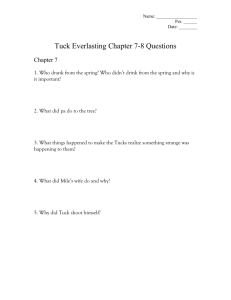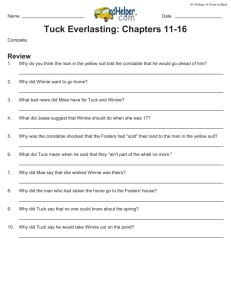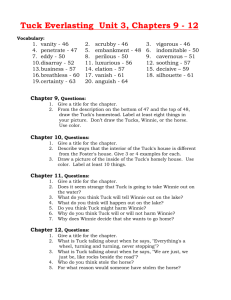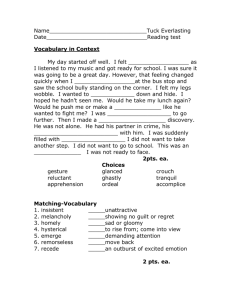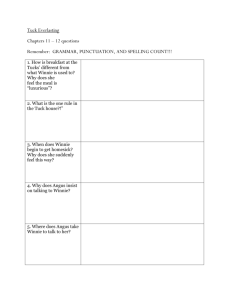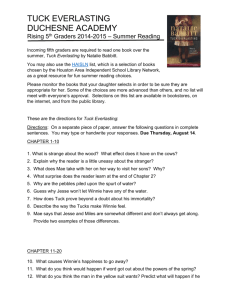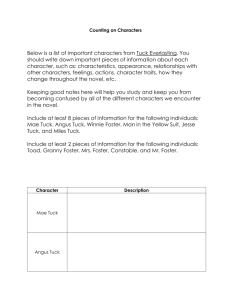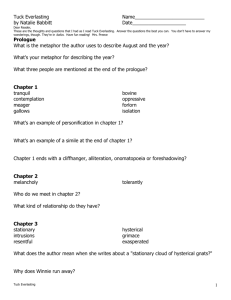Tuck Everlasting – Chapter Eleven
advertisement
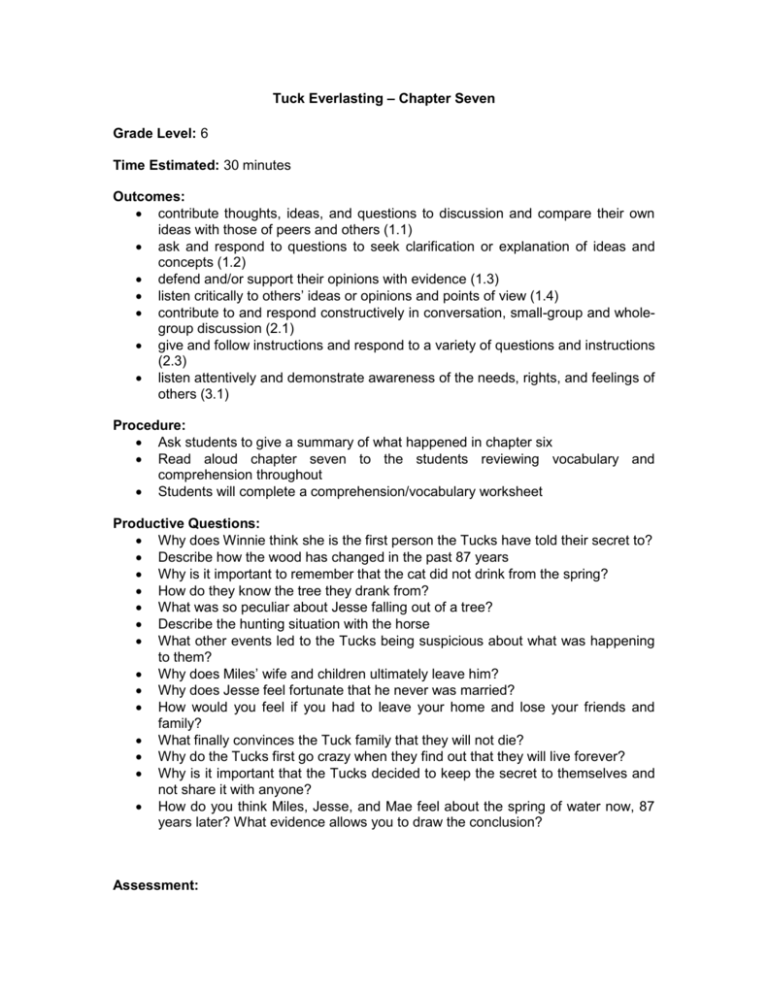
Tuck Everlasting – Chapter Seven Grade Level: 6 Time Estimated: 30 minutes Outcomes: contribute thoughts, ideas, and questions to discussion and compare their own ideas with those of peers and others (1.1) ask and respond to questions to seek clarification or explanation of ideas and concepts (1.2) defend and/or support their opinions with evidence (1.3) listen critically to others’ ideas or opinions and points of view (1.4) contribute to and respond constructively in conversation, small-group and wholegroup discussion (2.1) give and follow instructions and respond to a variety of questions and instructions (2.3) listen attentively and demonstrate awareness of the needs, rights, and feelings of others (3.1) Procedure: Ask students to give a summary of what happened in chapter six Read aloud chapter seven to the students reviewing vocabulary and comprehension throughout Students will complete a comprehension/vocabulary worksheet Productive Questions: Why does Winnie think she is the first person the Tucks have told their secret to? Describe how the wood has changed in the past 87 years Why is it important to remember that the cat did not drink from the spring? How do they know the tree they drank from? What was so peculiar about Jesse falling out of a tree? Describe the hunting situation with the horse What other events led to the Tucks being suspicious about what was happening to them? Why does Miles’ wife and children ultimately leave him? Why does Jesse feel fortunate that he never was married? How would you feel if you had to leave your home and lose your friends and family? What finally convinces the Tuck family that they will not die? Why do the Tucks first go crazy when they find out that they will live forever? Why is it important that the Tucks decided to keep the secret to themselves and not share it with anyone? How do you think Miles, Jesse, and Mae feel about the spring of water now, 87 years later? What evidence allows you to draw the conclusion? Assessment: Record students participation in class discussion Monitor students understanding of vocabulary and comprehension Review students comprehension/vocabulary worksheet Adaptations: Brooklyn and Nicole will complete comprehension questions using fusion keyboards Chapter 7 – Comprehension Answer the following questions based on what you remember in Chapter 7. What happened to the Tucks 87 years ago? ____________________________________________________________________ ____________________________________________________________________ Who drank from the spring? Who did not? ____________________________________________________________________ ____________________________________________________________________ What did Pa (Angus Tuck) do to the tree? ____________________________________________________________________ What events happened to make the Tuck’s realize something strange was happening to them? ____________________________________________________________________ ____________________________________________________________________ ____________________________________________________________________ Why did Tuck shoot himself? ____________________________________________________________________ ____________________________________________________________________ Chapter 7 - Vocabulary Unscramble the following vocabulary words from chapter 7 and use them in a sentence cipruela ____________________________________________________________________ ____________________________________________________________________ neisotn ____________________________________________________________________ ____________________________________________________________________ Tuck Everlasting – Chapter Eight Grade Level: 6 Time Estimated: 30 minutes Outcomes: contribute thoughts, ideas, and questions to discussion and compare their own ideas with those of peers and others (1.1) ask and respond to questions to seek clarification or explanation of ideas and concepts (1.2) defend and/or support their opinions with evidence (1.3) listen critically to others’ ideas or opinions and points of view (1.4) contribute to and respond constructively in conversation, small-group and wholegroup discussion (2.1) give and follow instructions and respond to a variety of questions and instructions (2.3) listen attentively and demonstrate awareness of the needs, rights, and feelings of others (3.1) Procedure: Ask students to give a summary of what happened in chapter seven Read aloud chapter eight to the students reviewing vocabulary and comprehension throughout Students will complete an enrichment activity/ pair and share Productive Questions: Why does it feel great for the Tucks to finally tell someone about their secret? Will Winnie be able to keep their secret? Why or why not? Why does Winnie not feel 100% sure that it is a true story? Why do you think Jesse looks at the spring water as good, whereas Miles doesn’t seem so optimistic? What does it mean to be a parson? Why does Mae think that their secret is so dangerous? Why is it important for Mae to take Winnie back to Tuck? How do you think Tuck will react when he sees Winnie? What causes Winnie to feel such a comfort with the Tucks, as though they are her friends? Why does Winnie feel such pride in having her own friends? Who also discovers the Tucks secret? Why is he grinning after hearing the whole story? What do you think the man in the yellow suit will do with the Tucks secret? Assessment: Record students participation in class discussion Monitor students understanding of vocabulary and comprehension Review students enrichment worksheet Adaptations: Brooklyn and Nicole will complete enrichment activity using fusion keyboards and will pair up with another student to compare answers Chapter 8 – Enrichment Mae Tuck says that the spring is “a big, dangerous secret.” Do you agree? Why? ____________________________________________________________________ ____________________________________________________________________ ____________________________________________________________________ What might happen if the secret was revealed to the public? ____________________________________________________________________ ____________________________________________________________________ ____________________________________________________________________ How would people’s lives be changed for better or worse? ____________________________________________________________________ ____________________________________________________________________ ____________________________________________________________________ How might the planet be affected? ____________________________________________________________________ ____________________________________________________________________ ____________________________________________________________________ Do you think the spring should be kept a secret? ____________________________________________________________________ ____________________________________________________________________ ____________________________________________________________________ * Pair up with a partner and compare your answers * Tuck Everlasting – Chapter Nine Grade Level: 6 Time Estimated: 30 minutes Outcomes: contribute thoughts, ideas, and questions to discussion and compare their own ideas with those of peers and others (1.1) ask and respond to questions to seek clarification or explanation of ideas and concepts (1.2) defend and/or support their opinions with evidence (1.3) listen critically to others’ ideas or opinions and points of view (1.4) contribute to and respond constructively in conversation, small-group and wholegroup discussion (2.1) give and follow instructions and respond to a variety of questions and instructions (2.3) listen attentively and demonstrate awareness of the needs, rights, and feelings of others (3.1) Procedure: Ask students to give a summary of what happened in chapter eight Read aloud chapter nine to the students reviewing vocabulary comprehension throughout Students will complete a character carousel activity and Carousel Activity Hang 6 large sheets of construction paper in various places around the room for students to write on. On top of the sheets of paper must be the name of one of the main characters. Names needed: Winnie Foster Jesse Tuck Miles Tuck Mae Tuck Angus Tuck Man in the yellow suit 1. Divide students evenly into 6 groups and have them stand in front of one of the character posters. 2. Hand a different colored marker to each group and assign a note taker for the first character. The note taker will be responsible for documenting any information their classmates give them. 3. Give the groups about one minute to record as much information as they can about the character on the chart paper. Allow them to add appearances, actions, events they have taken part in, character traits, etc. 4. After one minute, have students rotate to the next character poster and assign another note taker. 5. Give the students about 30 seconds to read what their classmates have already written on the poster. 6. Tell students to place a star next to any piece of information they agree with and a question mark next to any piece of information they are not sure about. 7. Then give them another minute or so to record more information about the character's poster they are at. 8. Continue this process, alternating note takers, until the groups have recorded information about all six characters. 9. Have students return to their seats and reflect upon what is written as a whole class. Ask students: Do you have any questions for any other groups after you read what was written? How did this activity help you to learn more about the characters? Why was it important to add a star next to each piece of information you agreed with? What new pieces of information did you learn about the characters of Tuck Everlasting? 10. Take down the posters and save them for a continuation of this activity next week. Productive Questions: Describe what Winnie is seeing and feeling as she is going to the Tucks home Why did everything around the Tucks’ home appear to be silent and untouched? What was Tuck’s reaction right when he came out to see Winnie? Why do you think Tuck demanded to see the child? How do you think Tuck was originally feeling when Miles and Jesse told him there was a real honest to goodness child with them? Why was Winnie first shy around Tuck? Why was Tuck so hesitant to say that it was the best thing that had happened to their family in…and he didn’t mention the years? How do you think the Tuck family will change now that Winnie is around? How has Tuck already changed from his melancholy creases on his face to exclaiming that Winnie was the best thing that had happened to his family in 80 years? Assessment: Record students participation in class discussion Monitor students understanding of vocabulary and comprehension Monitor the information students added to each character Adaptations: Brooklyn and Nicole will take part in the character carousel Tuck Everlasting – Chapter Ten Grade Level: 6 Time Estimated: 30 minutes Outcomes: contribute thoughts, ideas, and questions to discussion and compare their own ideas with those of peers and others (1.1) ask and respond to questions to seek clarification or explanation of ideas and concepts (1.2) defend and/or support their opinions with evidence (1.3) listen critically to others’ ideas or opinions and points of view (1.4) contribute to and respond constructively in conversation, small-group and wholegroup discussion (2.1) give and follow instructions and respond to a variety of questions and instructions (2.3) listen attentively and demonstrate awareness of the needs, rights, and feelings of others (3.1) Procedure: Ask students to give a summary of what happened in chapter nine Read aloud chapter ten to the students reviewing vocabulary and comprehension throughout Students will play “Who am I?” game to review Who am I? Game Rules Divide the class into two teams Have one person from one team stand up infront of the class with a word that they cannot see (tape the word to their back). This word will be a person, place, or thing from the chapters read in the novel thus far. The student “is” that word and they have to figure out what or who they are. Everyone but the selected student knows the word. It is up to the student to ask their teammates for “yes” or “no” questions to figure our who or what they are. The team member will have ten chances to find out who they are The next team will choose a member to go up and become a word and the game will go on until all of the words have been completed. Stress the importance of asking who am I questions and not just giving names of places and things related to the book. This will result in losing their turn. Productive Questions: How is Winnie’s home different from the Tucks? What do you think was going through Winnies mind when she stepped foot in the Tucks home? What does the author mean when she stated that Winnie was in training to be like her mother and grandmother? Has your family trained you to be similar in their own ways? Explain. Describe the appearance of the Tucks home How do you think the Tucks feel about keeping their house tidy? Why do they feel that way? How do you think the Tuck family will change now that Winnie is around? How has Tuck already changed from his melancholy creases on his face to exclaiming that Winnie was the best thing that had happened to his family in 80 years? Assessment: Record students participation in class discussion Monitor students understanding of vocabulary and comprehension Monitor the information students added to each other Adaptations: Brooklyn and Nicole will take part in the character carousel Tuck Everlasting – Chapter Eleven Grade Level: 6 Time Estimated: 30 minutes Outcomes: contribute thoughts, ideas, and questions to discussion and compare their own ideas with those of peers and others (1.1) ask and respond to questions to seek clarification or explanation of ideas and concepts (1.2) defend and/or support their opinions with evidence (1.3) listen critically to others’ ideas or opinions and points of view (1.4) contribute to and respond constructively in conversation, small-group and wholegroup discussion (2.1) give and follow instructions and respond to a variety of questions and instructions (2.3) listen attentively and demonstrate awareness of the needs, rights, and feelings of others (3.1) Procedure: Ask students to give a summary of what happened in chapter ten Read aloud chapter eleven to the students reviewing vocabulary and comprehension throughout Discuss the difference between metaphors, similies, and personification with students Students will complete a figurative language activity Once students have completed the activity, review it together as a class to determine students understanding Productive Questions: Why would Winnie be observant of any rules the Tucks might have at dinner? Do you think it is important to follow rules or guidelines of someone else’s home if you are a guest? Why? Why did the meal seem so luxurious to Winnie even though it wasn’t as proper as she was used to? What is the one rule the Tucks followed when they were eating? Are there any rules your family follows when you are eating? Why does Winnie feel as though she cannot fit into the Tuck’s world, especially when they are eating? What made Winnie begin to think the Tucks were crazy? How do you feel about them? Why are all of the men of the Tuck family insisting on taking Winnie out for a row on the pond? What do you think they want to discuss with her? What causes Winnie to feel a sigh of relief when she mentions that the man in the yellow suit knows her? Do you think she actually wants to leave the Tucks? Why does Tuck feel so bad about his family scaring young children? Do you think that was their intention all along? What does Tuck mean when he says, “we got to get you home just as fast as we can. I got a feeling this whole thing is going to come apart like wet bread?” What are your predictions about the future for Winnie and the Tucks? Assessment: Record students participation in class discussion Review figurative language activity Adaptations: Brooklyn was very attentive last class and had a lot to add to the discussion in relation to the Tucks home and way of life. For this lesson she will have an opportunity to compare the Tuck’s house and way of life with the Fosters using the fusion keyboard Nicole is away - NA Tuck Everlasting – Figurative Language Tuck Everlasting is made interesting both by its exciting plot and by its use of figurative language. The story is enriched with similies, metaphors, and personification. A similie compares things to one another by using the word as or like. It helps to better describe how something looks, feels, smells, tastes, or sounds by comparing the object to something else with which we are familiar. Example: “this weary old earth…would have trembled on its axis like a beetle on a pin” A metaphor also compares two different things, but it does not use a word of comparison such as like or as Example: “at this, the toad stirred and blinked. It gave a heave of muscles and plopped its heavy mudball of a body a few inches farther away from her” Personification is a form of figurative language in which an animal or object is given human characteristics Example: “the graceful arms of the pines stretched our protectively in every direction” Listed below are examples of figurative language found in Tuck Everlasting. On the space provided by each example, write the name of the type of figurative language. 1. ____________________ “…a stack of wooden bowls, their sides smoothed to velvet.” 2. ____________________ “…her backbone felt like a pipe full of running water…” 3. ____________________ “‘I’m about as dry as dust.’ ” 4. ____________________ “The sun was dropping fast now, a soft, red, sliding egg yolk…” 5. ____________________ “But at the same time he had a kind of grace, like a well oiled marionette.” 6. ____________________ “The sun was only just opening its own eye…” 7. ____________________ “It (the music) was like a ribbon tying her to familiar things.” 8. ____________________ “The last stains of sunset had melted away…” 9. ____________________ “…enclosed by a capable iron fence some four feet high which clearly said, ‘Move on – we don’t want you here’”. 10. ____________________ “…they gathered around her like children at their mothers knee.” Tuck Everlasting – Chapter Twelve Life as a wheel Grade Level: 6 Time Estimated: 30 minutes Outcomes: contribute thoughts, ideas, and questions to discussion and compare their own ideas with those of peers and others (1.1) ask and respond to questions to seek clarification or explanation of ideas and concepts (1.2) defend and/or support their opinions with evidence (1.3) listen critically to others’ ideas or opinions and points of view (1.4) contribute to and respond constructively in conversation, small-group and wholegroup discussion (2.1) give and follow instructions and respond to a variety of questions and instructions (2.3) listen attentively and demonstrate awareness of the needs, rights, and feelings of others (3.1) Procedure: Ask students to give a summary of what happened in chapter eleven Read aloud chapter twelve to the students reviewing vocabulary and comprehension throughout Have a class discussion on the following: Tuck described life as “moving, growing, changing, never the same two minutes together.” He said, “living’s heavy work.” Discussion: Life 1. How would you describe life? 2. What is the difference between living and life? 3. Is living heavy work? Why or why not? 4. Is living harder for some than others? Easier for some than others? 5. Can you make life easier for someone? 6. Can you make life easier for yourself? 7. Can someone make life easier for you? 8. Is life always work? What else can it be? 9. What does it mean to say that someone is “full of life”? Tuck compared life to a wheel “turning and turning, never stopping.” He described the water cycle as an example. Discussion: Life as a wheel What do you think Tuck meant when he compared life to a wheel? Activity: Life as a wheel Provide students with a diagram of a water cycle – have them describe what they see Discuss the human life cycle as a class and than have students create their version of the life cycle on a blank sheet of paper. Students will need to label the cycle, using terms that refer to the life cycle: birth, infancy, childhood, adolescence, adulthood, middle age, old age, and death. If students finish early they can complete the life and living activity below Activity: Life and Living Tuck uses several “ing” words to describe life and living. He calls life moving, growing, changing, and turning. With a partner, students will make a list of all the “ing” words they can think of that would describe life and living. Productive Questions: Describe the setting Winnie and Tuck are experiencing on the rowboat. Why do you think the author goes into such detail about the images surrounding the characters? How does Tuck compare his life to that of the life in the pond? Why do you think he did this for Winnie? Do you think that most people don’t pay attention to life moving around them? Why do you think people are in such a hurry and forget to notice the small changes? How are the Tucks different than life in the pond? Do you think Tuck likes the way he has to live his life? Why? How is the Tucks’ life similar and different to a wheel? How is Tuck able to help Winnie to make sense of why it is important that no one knows their secret? What does Tuck mean when he says, “We just are, we just be, like rocks beside a road?” Do you ever feel as though you are stuck and can’t move? What normally happens after you have this feeling? Put yourself in the Tucks situation of being stuck, how do you think you would feel? What are some reasons Tuck gives to let Winnie know that the spring water is not good for people to discover? Why do you think the horse is stolen? Who took the horse? Assessment: Record students participation in class discussion Review students diagram of a life cycle Adaptations: Brooklyn will complete the life cycle diagram Nicole is away for the week Tuck Everlasting - Life and Living Tuck uses several “ing” words to describe life and living. He calls life moving, growing, changing, and turning. With a partner, make a list below of all the “ing” words you can think of that would describe life and living. ______________________________ ______________________________ ______________________________ ______________________________ ______________________________ ______________________________ ______________________________ ______________________________ ______________________________ ______________________________ ______________________________ ______________________________ ______________________________ ______________________________ ______________________________ ______________________________ ______________________________ ______________________________ ______________________________ ______________________________ ______________________________ ______________________________ ______________________________ ______________________________ ______________________________ ______________________________ ______________________________ ______________________________ ______________________________ ______________________________ ______________________________ ______________________________ ______________________________ ______________________________ Tuck Everlasting – Chapter Thirteen and Fourteen Choice of Words Grade Level: 6 Time Estimated: 30 minutes Outcomes: contribute thoughts, ideas, and questions to discussion and compare their own ideas with those of peers and others (1.1) ask and respond to questions to seek clarification or explanation of ideas and concepts (1.2) defend and/or support their opinions with evidence (1.3) listen critically to others’ ideas or opinions and points of view (1.4) contribute to and respond constructively in conversation, small-group and wholegroup discussion (2.1) give and follow instructions and respond to a variety of questions and instructions (2.3) listen attentively and demonstrate awareness of the needs, rights, and feelings of others (3.1) Procedure: Ask students to give a summary of what happened in chapter twelve Read aloud chapter thirteen and fourteen to the students reviewing vocabulary and comprehension throughout Chapter thirteen is only half a page; however there is a lot of descriptive imagery. Discuss the authors choice of words in the chapter and within the novel thus far (refer back to Mondays activity on figurative language) Time permitting, have students complete a word choice activity “The man in the yellow suit took off his hat and smoothed his hair with long white fingers.” “The window glowed golden.” Discussion: Choice of words 1. The author used particular words to bring pictures to our minds. “Long white fingers” makes us see the stranger’s hands. Why do you think she used the word long? The word white? 2. “The window glowed golden “produces another picture. What other things can glow? What other things are golden? What other words could the author have used? 3. How do we choose the words we use? 4. Do we choose words differently for different people? Different occasions? 5. Do we choose words differently when we speak than when we write? 6. Do we ever not choose our words? 7. Are there times when we have no choice? 8. Can words mean one thing to one person and another thing to someone else? What makes the difference? 9. Can our choices get us in trouble? Get us rewarded? 10. Are there words everyone uses? Words no one uses? 11. Are there words no one should use? 12. Should you use words no one else understands? Another language? Chapter 13 - Productive Questions: Why do you think the man in the yellow suit took the Tucks’ horse? Why are the lights on in the Fosters’ home? What motivation does the man in the yellow suit have for telling the Foster’s that he knows where Winnie is? How do you think the Foster’s will react to the man in the yellow suit? Do you think grandmother will think that the man in the yellow suit had something to do with Winnie’s disappearance? Why or why not? Chapter 14 - Productive Questions: Why didn’t the Tucks rush out to find out what happened with the horse? Describe how you think each member of the Tuck family is feeling about the missing horse? Do you think they put any blame on Winnie for this happening? Why was Winnie having such a difficult time sleeping? Who came to visit Winnie while she was laying down? Why didn’t Miles come to visit Winnie, but the rest of the family did? Do you think Winnie regrets going into the woods to prove to the Toad that she could run away? Do you think the toad would think she was a coward now? Why or why not? Why do you think Winnie can’t determine if the Tucks are telling the truth or not? Is the secret too far fetched for anyone to believe? Is Winnie right in being hopeful that her dad will come and find her and he is probably out searching for her that very minute? Why? Why does Mae feel so remorseful about what has happened with Winnie? Do you think this comforts Winnie to know? Why or why not? How is it both good and bad that the Tucks have Winnie at their home? How is Tuck treating Winnie like a daughter? Why do you think he feels so attached to her? Are the Tucks’ criminals in your mind? Why or why not? How does Winnie feel about Jesse? How do you now? What proposition does Jesse propose to Winnie? How does she react? Why do you think Jesse wants to marry Winnie? How will it be beneficial to him? Will it be as beneficial to her? Assessment: Record students participation in class discussion Review word choice activity Adaptations: Brooklyn will complete a similar version of the word choice activity using the fusion keyboard. She will highlight all of the descriptive words within each sentence. Nicole is away Choice of words Below are some examples of carefully and skillfully chosen words the author used within the novel. Write a “plain word” translation for the author’s phrase or sentence. If the word brings a picture to mind, illustrate the words. Example: “Mae sat there frowning, a great potato of a woman with a round, sensible face and calm brown eyes.” Plain word translation: Mae sat there frowning. She was a large woman with a round face and brown eyes. “I’m about as dry as dust.” Translation: _______________________________________________ “…three armchairs and an elderly rocker stood about aimlessly, like strangers at a party, ignoring each other.” Translation: _______________________________________________ “Yes, it was the same music she had heard the night before. Somehow it calmed her. It was like a ribbon tying her to familiar things.” Translation: _______________________________________________ “The sky was a ragged blaze of red, and pink, and orange, and its double trembled on the surface of the pond like colour spilled from a paintbox.” Translation: _______________________________________________ “He was thin and sunburned, this wonderful boy, with a thick mop of curly brown hair, and he wore his battered trousers and loose grubby shirt…” Translation: _______________________________________________ Choice of words Below are some examples of carefully chosen words the author used within the novel. Highlight all of the descriptive words you see within each sentence. Example: “Mae sat there frowning, a great potato of a woman with a round, sensible face and calm brown eyes.” “I’m about as dry as dust.” “…three armchairs and an elderly rocker stood about aimlessly, like strangers at a party, ignoring each other.” “Yes, it was the same music she had heard the night before. Somehow it calmed her. It was like a ribbon tying her to familiar things.” “The sky was a ragged blaze of red, and pink, and orange, and its double trembled on the surface of the pond like colour spilled from a paintbox.” “The man in the yellow suit took off his hat and smoothed his hair with long white fingers.” Tuck Everlasting – Chapter Fifteen Grade Level: 6 Time Estimated: 30 minutes Outcomes: contribute thoughts, ideas, and questions to discussion and compare their own ideas with those of peers and others (1.1) ask and respond to questions to seek clarification or explanation of ideas and concepts (1.2) defend and/or support their opinions with evidence (1.3) listen critically to others’ ideas or opinions and points of view (1.4) contribute to and respond constructively in conversation, small-group and wholegroup discussion (2.1) give and follow instructions and respond to a variety of questions and instructions (2.3) listen attentively and demonstrate awareness of the needs, rights, and feelings of others (3.1) Procedure: Ask students to give a summary of what happened in chapter thirteen and fourteen Read aloud chapter fifteen to the students reviewing vocabulary and comprehension throughout Have a class discussion on illiteracy and human worth Students will complete a comprehension activity with questions based on the chapter The stranger said of the Tucks, “There’s no telling what illiterates like that might do.” Discussion: Illiteracy 1. What is illiteracy? 2. Who is an illiterate? 3. Can a smart person be illiterate? 4. Does being illiterate make someone less of a person? 5. Does being illiterate make someone bad? 6. Does being illiterate make someone stupid? 7. Can someone choose to be illiterate? 8. Are there any benefits to being illiterate? 10. Are there any other ways of being illiterate other than being unable to read? 11. Can someone be a movie illiterate? A computer illiterate? A math illiterate? The stranger called his blackmail “a simple, clear-cut trade.” Discussion: Human worth 1. Can you trade someone for something? 2. Can you buy or sell someone? 3. How much is a human being worth? 4. Are some people worth more than others? 5. Who determines your worth? 6. Are people more valuable than things? Are there things more valuable than people? 7. When a general sends troops into combat, knowing that some will be killed, is he trading their lives for something? Are the troops trading their lives for something? 8. What is worth trading your life for? Productive Questions: Is the man in the yellow suit telling the Foster’s the whole truth about following Winnie? Do you think he has an alternative motive in trying to help Winnie? Why is the wood a prize for the man in the yellow suit to win? Are the Tucks truly rough country people like the man in the yellow suit is claiming them to be? How does the man in the yellow suit manipulate the Foster’s into getting what he wants? Do the Foster’s have any choice but to hand over the woods to the man in the yellow suit? What would you have done in return? Is a life more valuable than property? Why do you feel this way? Why does the man in the yellow suit insist that Mr. Foster stays at home and he handles the business himself with the constable? Should the Foster’s be thankful that the man in the yellow suit is so eagerly willing to help them out? What do you think the man in the yellow suit will do now? Assessment: Record students participation in class discussion Review comprehension activity Adaptations: Brooklyn will complete the comprehension activity Nicole is away for the week Comprehension 1. What was the one rule that the Tuck family followed while eating their supper? __________________________________________________________________ __________________________________________________________________ 2. Tuck compared the pond water and life to what object? Why did he compare these two items? __________________________________________________________________ __________________________________________________________________ __________________________________________________________________ 3. Who stole Tuck’s horse? ________________________________ 4. Why couldn’t Winnie get to sleep at the Tuck’s house? __________________________________________________________________ __________________________________________________________________ 5. What deal did the man in the yellow suit make with the Fosters? __________________________________________________________________ __________________________________________________________________ What did he want done concerning the deal? __________________________________________________________________ __________________________________________________________________ Write the following words in alphabetical order: Sensible, swung, secretly, seized, sturdy, sense, suspenders, strayed, sunset Tuck Everlasting – Chapter Sixteen Grade Level: 6 Time Estimated: 30 minutes Outcomes: contribute thoughts, ideas, and questions to discussion and compare their own ideas with those of peers and others (1.1) ask and respond to questions to seek clarification or explanation of ideas and concepts (1.2) defend and/or support their opinions with evidence (1.3) listen critically to others’ ideas or opinions and points of view (1.4) contribute to and respond constructively in conversation, small-group and wholegroup discussion (2.1) give and follow instructions and respond to a variety of questions and instructions (2.3) listen attentively and demonstrate awareness of the needs, rights, and feelings of others (3.1) Procedure: Ask students to give a summary of what happened in chapter fifteen Read aloud chapter sixteen to the students reviewing vocabulary and comprehension throughout Students will play a game to review the chapters read so far Productive Questions: Describe the constable’s personality? Is he the type of sheriff you would like helping you to rescue a kidnapped individual? What does the constable mean when he says, “How come you’re so deep in it?” Do you think he has a reason to be suspicious of the man in the yellow suit? Why? Why do you think the man in the yellow suit makes it a point to let the constable know that the Foster’s are his friends and they sold him the woods? How is the process of finding a kidnapped person different today than how it is described in Tuck Everlasting? Describe how the town of Treegap must be considering the Constable mentioned that he never had dealt with a kidnapping before? How would having gallows in the town help to keep down trouble? What types of things are around in your environment to help keep down the trouble? Why is the man in the yellow suit so eager to ride ahead of the Constable and get to Winnie first? He is genuinely interested in saving Winnie? How do you think the Constable would have reacted if he had known that the man in the yellow suit had committed a crime himself by stealing the Tucks’ horse? What will happen when the man in the yellow suit arrives at the Tucks ahead of the constable? Assessment: Record students participation in class discussion Review students participation during the game Adaptations: Brooklyn will take part in the game Nicole is away for the week Tuck Everlasting – Chapter Eighteen Grade Level: 6 Time Estimated: 30 minutes Outcomes: contribute thoughts, ideas, and questions to discussion and compare their own ideas with those of peers and others (1.1) ask and respond to questions to seek clarification or explanation of ideas and concepts (1.2) defend and/or support their opinions with evidence (1.3) listen critically to others’ ideas or opinions and points of view (1.4) contribute to and respond constructively in conversation, small-group and wholegroup discussion (2.1) give and follow instructions and respond to a variety of questions and instructions (2.3) listen attentively and demonstrate awareness of the needs, rights, and feelings of others (3.1) Procedure: Ask students to give a summary of what happened in chapter seventeen Read aloud chapter eighteen to students reviewing vocabulary and comprehension throughout Students will continue the character carousel activity. They will review what was previously written about the characters from the last activity to ensure the information is correct and than will be given time to add any new information. Productive Questions: Why didn’t Miles blame Winnie for them not catching any fish for dinner? Why was Winnie’s stomach fluttering so much when she saw Jesse? Do you think she will actually consider taking his proposition of drinking the spring water? Why does Mae think that having Winnie there with them for breakfast is like having a party? How has Winnie’s presence in the Tuck home changed both Winnie and the Tucks? Do you think it was necessary for Tuck to state that they had business to discuss at the breakfast table? Why or why not? Why was it important to Winnie to think that the Tucks belonged to her? How is Winnie’s behaviour different between the dinner and breakfast? What factors do you think affected this? Why do you think that Tuck was so dear to Winnie? What about him would draw Winnie to him? Why does a knock at the Tuck’s door seem like such an alien sound to them? Who do you think is knocking at the Tucks door and what are they doing there? The man in the yellow suit’s voice is described as being pleasant, do you think he is a pleasant individual? Why or why not? How does the man in the yellow suit know that Mae’s name is Mrs. Tuck? What do you think the man in the yellow suit will want to discuss with the Tucks? Assessment: Record students participation in class discussion Monitor students understanding of vocabulary and comprehension Monitor the information students added to each character Adaptations: Brooklyn and Nicole will take part in the Carousel activity Tuck Everlasting – Chapter Nineteen Grade Level: 6 Time Estimated: 30 minutes Outcomes: contribute thoughts, ideas, and questions to discussion and compare their own ideas with those of peers and others (1.1) ask and respond to questions to seek clarification or explanation of ideas and concepts (1.2) defend and/or support their opinions with evidence (1.3) listen critically to others’ ideas or opinions and points of view (1.4) contribute to and respond constructively in conversation, small-group and wholegroup discussion (2.1) give and follow instructions and respond to a variety of questions and instructions (2.3) listen attentively and demonstrate awareness of the needs, rights, and feelings of others (3.1) Procedure: Ask students to give a summary of what happened in chapter eighteen Read aloud chapter nineteen to students reviewing vocabulary and comprehension throughout This is a fairly long chapter which will generate a lot of discussion. Time permitting, students will complete a comprehension activity Productive Questions: What do you think caused the man in the yellow suit to have an unpleasant look in his face even though he wasn’t showing any expressions? Do you think Winnie will feel safe with the man in the yellow suit? Why or why not? Is it true when Angus Tuck says, “Winnie ain’t been in no danger”? How did the man in the yellow suit say that Miles wife left him? What does Mae mean when she says, “you got no call to come and bring us pain”!? Why do the Tucks seem so incredibly impatient with the man in the yellow suit and why do they want him to just spit out what he has come for? Do you think the Tucks have justifiable reason to be irritated with the man in the yellow suit? Do they have reason to be suspicious of him? Why? Why do you think the man in the yellow suit devoted his life to finding out about the family that never ages? What reminder did the man in the yellow suit’s grandmother have on Mae Tuck? How did Mae’s music box lead the man in the yellow suit to the Tuck’s home? Does the spring actually belong to the man in the yellow suit? What makes you believe this? Why don’t the man in the yellow suit sell the spring water to just anybody, why does it have to be people who deserve it? Do you think one individual has the right to decide what people deserve to live forever? What does the man in the yellow suit mean when he says, “ignorant people like you should never have had the opportunity to drink from the spring water”? Why does the man in the yellow suit decide to have the Tuck’s help him out with selling the spring water? Do you think it was truly gentlemanly of the man in the yellow suit to offer the Tuck’s an opportunity to join in his selling of the spring water? Why or why not? Why are the Tucks so furious with the man in the yellow suit? Are the Tucks really being selfish by keeping the spring water a secret? Why or why not? Describe Mae’s reaction to the man in the yellow suit trying to take Winnie Why was it unfortunate for the constable to witness Mae’s reaction? What consequence do you think will follow Mae after hitting the man in the yellow suit with a shotgun? Assessment: Record students participation in class discussion Monitor students understanding of vocabulary and comprehension Review students comprehension activity Adaptations: Brooklyn and Nicole will complete comprehension questions using the fusion keyboard Chapter 19 - Comprehension Answer the following question based on what you remember in chapter 19. What does Winnie notice about the man with the yellow suit that she had not noticed before? ____________________________________________________________________________ ____________________________________________________________________________ ____________________________________________________________________________ How does the man in the yellow suit first learn of the Tucks? ____________________________________________________________________________ ____________________________________________________________________________ ____________________________________________________________________________ What does the man in the yellow suit plan to do with the water from the spring? ____________________________________________________________________________ ____________________________________________________________________________ ____________________________________________________________________________ What does the stranger want the Tucks to do for him? ____________________________________________________________________________ ____________________________________________________________________________ ____________________________________________________________________________ What does Mae Tuck do to save Winnie from the stranger? ____________________________________________________________________________ ____________________________________________________________________________ ____________________________________________________________________________ Tuck Everlasting – Chapter Twenty Grade Level: 6 Time Estimated: 30 minutes Outcomes: contribute thoughts, ideas, and questions to discussion and compare their own ideas with those of peers and others (1.1) ask and respond to questions to seek clarification or explanation of ideas and concepts (1.2) defend and/or support their opinions with evidence (1.3) listen critically to others’ ideas or opinions and points of view (1.4) contribute to and respond constructively in conversation, small-group and wholegroup discussion (2.1) give and follow instructions and respond to a variety of questions and instructions (2.3) listen attentively and demonstrate awareness of the needs, rights, and feelings of others (3.1) Procedure: Ask students to give a summary of what happened in chapter nineteen Read aloud chapter twenty to students reviewing vocabulary and comprehension throughout Students will play a game to review the chapters read thus far Productive Questions: Why did Winnie hide herself in Tuck’s chest after the incident with Mae and the man in the yellow suit? How do you think you would have felt if you had just witnessed Mae hitting the man in the yellow suit over the head with a shotgun? Why do you think Mae was upset with the man in the yellow suit for taking Winnie against her will, even though she had done the same thing just a day ago? Who are the two situations similar and different? Is Winnie telling the constable the truth when she says at the Tucks did not kidnap her? Why do you think Winnie wants to protect the Tucks? Why do you think Natalie Babbitt describes the man in the yellow suits appearance on the ground to a marionette? Why was Tuck so entranced when he gazed at the man in the yellow suit’s sprawling body on the ground? What does the Constable mean when he says, “If he don’t make it, you’re in a pickle, you people,”? Do you think Mae is so dangerous that she deserves to be locked up in jail? Why or why not? What does Mae mean when she says, “Don’t worry about me none, I’ll make out,”? Why did the word gallows scare the Tucks so much? What would people discover is Mae was sent to the gallows? Do you think Winnie actually believes that everything will be alright when she says it to Tuck? Why was the thought of going home so distant from Winnie’s mind, even though the night before she was crying because she wanted to go home? How do you think Winnie will make a difference in helping Mae not go to the gallows? How have the possibilities for Winnie changed so much in one day? Assessment: Record students participation in class discussion Monitor students understanding of vocabulary and comprehension Record students participation during the game Adaptations: Brooklyn and Nicole will participate in the game
